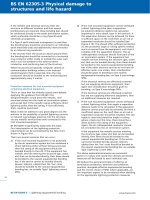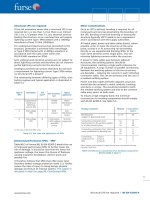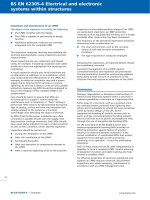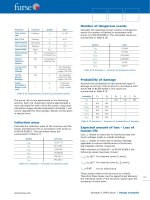Bsi bs en 00487 2009
Bạn đang xem bản rút gọn của tài liệu. Xem và tải ngay bản đầy đủ của tài liệu tại đây (261.18 KB, 16 trang )
BRITISH STANDARD
Aluminium and
aluminium alloys
— Rolling ingots —
Specifications
ICS 77.150.10
NO COPYING WITHOUT BSI PERMISSION EXCEPT AS PERMITTED BY COPYRIGHT LAW
BS EN 487:2009
BS EN 487:2009
National foreword
This British Standard is the UK implementation of EN 487:2009. It
supersedes BS EN 487:1994 which is withdrawn.
The UK participation in its preparation was entrusted to Technical
Committee NFE/35, Light metals and their alloys.
A list of organizations represented on this committee can be obtained on
request to its secretary.
This publication does not purport to include all the necessary provisions
of a contract. Users are responsible for its correct application.
Compliance with a British Standard cannot confer immunity
from legal obligations.
This British Standard
was published under
the authority of the
Standards Policy and
Strategy Committee on 30
September 2009
© BSI 2009
ISBN 978 0 580 62124 6
Amendments/corrigenda issued since publication
Date
Comments
BS EN 487:2009
EUROPEAN STANDARD
EN 487
NORME EUROPÉENNE
EUROPÄISCHE NORM
August 2009
ICS 77.150.10
Supersedes EN 487:1993
English Version
Aluminium and aluminium alloys - Rolling ingots - Specifications
Aluminium et alliages d'aluminium - Plaques de laminage Spécifications
Aluminium und Aluminiumlegierungen - Walzbarren Spezifikationen
This European Standard was approved by CEN on 24 July 2009.
CEN members are bound to comply with the CEN/CENELEC Internal Regulations which stipulate the conditions for giving this European
Standard the status of a national standard without any alteration. Up-to-date lists and bibliographical references concerning such national
standards may be obtained on application to the CEN Management Centre or to any CEN member.
This European Standard exists in three official versions (English, French, German). A version in any other language made by translation
under the responsibility of a CEN member into its own language and notified to the CEN Management Centre has the same status as the
official versions.
CEN members are the national standards bodies of Austria, Belgium, Bulgaria, Cyprus, Czech Republic, Denmark, Estonia, Finland,
France, Germany, Greece, Hungary, Iceland, Ireland, Italy, Latvia, Lithuania, Luxembourg, Malta, Netherlands, Norway, Poland, Portugal,
Romania, Slovakia, Slovenia, Spain, Sweden, Switzerland and United Kingdom.
EUROPEAN COMMITTEE FOR STANDARDIZATION
COMITÉ EUROPÉEN DE NORMALISATION
EUROPÄISCHES KOMITEE FÜR NORMUNG
Management Centre: Avenue Marnix 17, B-1000 Brussels
© 2009 CEN
All rights of exploitation in any form and by any means reserved
worldwide for CEN national Members.
Ref. No. EN 487:2009: E
BS EN 487:2009
EN 487:2009 (E)
Contents
Page
Foreword ..............................................................................................................................................................3
1
Scope ......................................................................................................................................................4
2
Normative references ............................................................................................................................4
3
Terms and definitions ...........................................................................................................................4
4
Ordering information .............................................................................................................................4
5
5.1
5.2
5.3
5.4
5.5
5.6
5.7
Requirements .........................................................................................................................................5
Production and manufacturing processes .........................................................................................5
Chemical composition ..........................................................................................................................5
Surface and internal quality..................................................................................................................6
Tolerances on dimensions ...................................................................................................................6
Tolerances of form.................................................................................................................................7
Sawing ....................................................................................................................................................9
Scalping ..................................................................................................................................................9
6
6.1
6.2
6.3
Test procedures .....................................................................................................................................9
Analysis of chemical composition .......................................................................................................9
Inspection of physical and metallurgical properties....................................................................... 10
Other tests ........................................................................................................................................... 10
7
7.1
7.2
Inspection documents ........................................................................................................................ 10
Certificate of mass and analysis ....................................................................................................... 10
Inspection certificate .......................................................................................................................... 10
8
8.1
8.2
8.3
Marking ................................................................................................................................................ 11
General ................................................................................................................................................. 11
Edge marking ...................................................................................................................................... 11
Top end marking ................................................................................................................................. 11
9
Packaging, transport and storage ..................................................................................................... 11
10
Complaints .......................................................................................................................................... 12
Bibliography ..................................................................................................................................................... 13
2
BS EN 487:2009
EN 487:2009 (E)
Foreword
This document (EN 487:2009) has been prepared by Technical Committee CEN/TC 132 “Aluminium and
aluminium alloys”, the secretariat of which is held by AFNOR.
This European Standard shall be given the status of a national standard, either by publication of an identical
text or by endorsement, at the latest by February 2010, and conflicting national standards shall be withdrawn
at the latest by February 2010.
Attention is drawn to the possibility that some of the elements of this document may be the subject of patent
rights. CEN [and/or CENELEC] shall not be held responsible for identifying any or all such patent rights.
This document supersedes EN 487:1993.
Within its programme of work, Technical Committee CEN/TC 132 entrusted CEN/TC 132/WG 2 "Extrusion
billets and rolling ingots" to revise EN 487:1993.
CEN/TC 132 affirms its policy that in the case when a patentee refuses to grant licences on standardised
standard products under reasonable and not discriminatory conditions, then this product shall be removed
from the corresponding standard.
According to the CEN/CENELEC Internal Regulations, the national standards organizations of the following
countries are bound to implement this European Standard: Austria, Belgium, Bulgaria, Cyprus, Czech
Republic, Denmark, Estonia, Finland, France, Germany, Greece, Hungary, Iceland, Ireland, Italy, Latvia,
Lithuania, Luxembourg, Malta, Netherlands, Norway, Poland, Portugal, Romania, Slovakia, Slovenia, Spain,
Sweden, Switzerland and the United Kingdom.
3
BS EN 487:2009
EN 487:2009 (E)
1
Scope
This European Standard specifies the general requirements to be met by rolling ingots of aluminium or
aluminium alloys obtained by semi-continuous vertical casting.
2
Normative references
The following referenced documents are indispensable for the application of this document. For dated
references, only the edition cited applies. For undated references, the latest edition of the referenced
document (including any amendments) applies.
EN 573-1, Aluminium and aluminium alloys — Chemical composition and form of wrought products — Part 1:
Numerical designation system
EN 573-2, Aluminium and aluminium alloys — Chemical composition and form of wrought products — Part 2:
Chemical symbol based designation system
EN 573-3, Aluminium and aluminium alloys — Chemical composition and form of wrought products — Part 3:
Chemical composition
EN 10204, Metallic products — Types of inspection documents
EN 12258-1:1998, Aluminium and aluminium alloys — Terms and definitions — Part 1: General terms
EN 14242, Aluminium and aluminium alloys — Chemical analysis — Inductively coupled plasma optical
emission spectral analysis
EN 14726, Aluminium and aluminium alloys — Chemical analysis — Guideline for spark optical emission
spectrometric analysis
3
Terms and definitions
For the purposes of this document, the terms and definitions given in EN 12258-1:1998 and the following
apply.
3.1
heat
quantity of liquid metal that has simultaneously undergone the same preparatory treatment in the furnace
before the casting operation
4
Ordering information
The ordering information shall define the product required and shall contain the following:
a)
the form of the product (rolling ingot);
b)
the designation of the aluminium or aluminium alloy according to EN 573-1 and 573-2 (or the purchaser
alloy designation after agreement between supplier and purchaser). Tighter limits than the composition
limits stated in EN 573-3 may be specified as required;
c)
whether as cast or homogenized. The homogenizing parameters should be agreed between the supplier
and the purchaser;
4
BS EN 487:2009
EN 487:2009 (E)
d)
the number of this European Standard;
e)
the dimensions and shape of the product:
1)
nominal thickness (expressed in millimetres);
2)
nominal width (expressed in millimetres);
3)
nominal length and tolerance if different from standard (expressed in millimetres);
4)
cross sectional profile details or drawing number (expressed in millimetres);
f)
sawing code (see 5.6.4);
g)
whether rolling ingots are to be supplied scalped or not;
h)
whether the rolling ingots are scalped or not before hot rolling;
i)
end use (e.g. foil, packaging) (see 5.1);
j)
quantity:
1)
mass (in metric tonnes) or number of pieces;
2)
quantity tolerances if required;
k)
any requirements for inspection documents (see Clause 7);
l)
any additional requirements agreed between supplier and purchaser (see Clause 7).
5
Requirements
5.1
Production and manufacturing processes
The product requirements as formulated in this clause normally are not sufficient for rolling ingots to meet the
purchaser's requirements for rolled products. Therefore, the purchaser shall give the manufacturer full details
concerning the end use requirements, so that the manufacturing conditions of the manufacturer may best be
adjusted to fulfil the requirements.
It is recommended that trial quantities be produced to confirm that the end use requirements are met. It is also
recommended that the purchaser asks the manufacturer to advise of any significant change in the
manufacturing processes which may affect the quality of the final product.
It is recommended that a quality assurance system be implemented as described in EN ISO 9000 and
EN ISO 9004.
5.2
Chemical composition
The chemical composition of the ingots shall conform to the compositions specified in EN 573-3.
It is recommended that tighter composition limits than those given in EN 573-3 be agreed between purchaser
and supplier as required.
Control of alkali metals and other specific trace elements is recommended:
a)
sodium and calcium for magnesium alloys;
5
BS EN 487:2009
EN 487:2009 (E)
b)
lithium for foil end use alloys;
c)
beryllium.
The maximum hydrogen content and the related measuring method should be agreed between supplier and
purchaser.
5.3
Surface and internal quality
To be suitable for rolling, after scalping or not as required, and subsequent processing, rolling ingots shall:
a)
have low level of casting surface defects, protruding metal, handling marks, oil, dirt and corrosion;
b)
have low level of inclusions, porosity, shrinkage cavities and cracks;
c)
have a suitable metallurgical structure (e.g. grain size, shell zone depth, fir-tree structure).
The level of quality should be agreed between purchaser and supplier.
5.4
Tolerances on dimensions
5.4.1
Cross-section
The shape of the cross-section is left to the discretion of the purchaser, who shall give the supplier a
dimensional drawing.
5.4.2
Thickness
The thickness is measured on both sides of the ingot at a distance of 100 mm from the edges. The tolerance
on the thickness thus measured is ± 5 mm excluding (see Figure 1):
a)
a distance from the bottom butt of the unsawn rolling ingot of 80 % of the nominal thickness (distance
measured before sawing, if any);
NOTE
b)
For ingots more than 2 m wide, the distance is equal to the thickness.
a distance from the bottom end of the sawn rolling ingot of 50 % of the nominal thickness.
The tolerance on thickness in the zones defined above and measured at the centre of the cross-section is:
c)
4 % of the nominal thickness for sawn ingots;
d)
to be agreed between the purchaser and the supplier for unsawn ingots.
Other tolerances and measuring positions can be specified between the supplier and the purchaser.
The difference between the thinnest and the thickest parts of the sawn ingot measured anywhere on the ingot
at a distance greater than 100 mm from the edges shall not exceed 5 % of the nominal thickness.
6
BS EN 487:2009
EN 487:2009 (E)
a) Unsawn rolling ingot
b) Sawn rolling ingot
Key
t
nominal thickness
NOTE
The hatching corresponds to the zone in which thickness, width and deflections are measured.
Figure 1 — Rolling ingot type
5.4.3
Width
The width is measured overall. The tolerance on width is
+ 10
0
mm excluding a distance from the bottom butt of
the rolling ingot of 80 % of the nominal thickness (ingot with unsawn butt) or 50 % of the nominal thickness
(ingot with sawn butt) (see Figure 1).
Other tolerances may be agreed between the purchaser and the supplier as required.
5.4.4
Length
The length is measured overall. The tolerance on length is:
a)
± 25 mm for sawn ingots;
b)
± 50 mm for unsawn ingots;
unless otherwise stated in the ordering information.
5.5
5.5.1
Tolerances of form
Lateral deflection
The lateral deflection is the deflection measured along an edge in the casting direction, at the middle of the
edge.
The maximum permissible deflection on the length of the rolling ingot is 6 mm (see Figure 2).
5.5.2
Longitudinal deflection
The longitudinal deflection is the deflection measured along a rolling face in the casting direction, at 100 mm
from one corner.
7
BS EN 487:2009
EN 487:2009 (E)
The maximum permissible deflection on the length of the ingot is 6 mm (see Figure 2).
5.5.3
Diagonal deflection
The diagonal deflection is the deflection measured along a diagonal line of a rolling face. It qualifies the twist
of the rolling ingot.
The maximum permissible deflection is 6 mm (see Figure 2).
5.5.4
Transverse deflection (concavity and convexity)
The transverse deflection is measured on a rolling face in the direction perpendicular to the casting direction.
It measures the concavity or convexity of the ingot.
The maximum permissible transverse deflection is ± 3 mm (see Figure 2).
If the rolling ingot is not scalped before rolling, the maximum permissible transverse deflection is to be agreed
between the purchaser and the supplier.
Key
A
lateral deflection
B
C
longitudinal deflection
transverse deflection
D
diagonal deflection
NOTE
The lateral, longitudinal, diagonal and transverse deflections are measured on the length of the product
excluding the bottom butt zone corresponding to a length equal to 80 % of the nominal thickness (unsawn butt) or 50 % of
the nominal thickness (sawn butt) (see Figure 1).
Figure 2 — Deflection type
8
BS EN 487:2009
EN 487:2009 (E)
5.5.5
Squareness
The cuts shall be at 90° ± 1° from any generating line of the rolling ingot (casting axis).
5.6
Sawing
5.6.1
General
The rolling ingots can be:
a)
as cast if the top and bottom butts do not have to be removed as described below; or
b)
sawn.
Sawing can be performed at the top and/or bottom butt.
5.6.2
Top butt sawing
Top butt sawing shall be sufficient to remove shrink cavity and any defective metal.
5.6.3
Bottom butt sawing
Bottom butt sawing shall give a rolling ingot within flatness tolerances and remove defective metal.
5.6.4
Sawing code
Table 1 gives the sawing code as a function of the type of sawing.
Table 1 — Sawing code function of sawing type
a
Top butt sawing
Bottom butt sawing
Code a
no
no
NS
yes
no
TS
no
yes
BS
yes
yes
DS
NS stands for not sawn.
TS stands for top sawn.
BS stands for bottom sawn.
DS stands for double sawn (top and bottom).
5.7
Scalping
Scalping parameters and special dimensional requirements for scalped ingots shall be agreed between the
supplier and purchaser. They shall be covered under the additional requirements in the ordering information.
6
6.1
Test procedures
Analysis of chemical composition
The analytical samples shall be taken at the discretion of the manufacturer who shall use methods accepted
at European level, EN 14242 and EN 14726, or at International level.
9
BS EN 487:2009
EN 487:2009 (E)
The analytical samples shall be taken during the cast, from the metal distribution system, after the grain
refiner addition (if any).
The analytical samples shall be suitably machined and, when analysed by emission spectrometry, shall be
subject to at least two determinations. The sample result is the arithmetic mean of the determinations.
The final result is the arithmetic mean of the results of the taken samples.
For cast acceptance, each sample shall meet the specified composition limits.
The manufacturer shall use analytical methods standardized at European or International level, e.g. SPC
(Statistical Process Control). The choice of appropriate methods is at the discretion of the manufacturer.
6.2
Inspection of physical and metallurgical properties
6.2.1
Dimensional characteristics
The manufacturer shall employ adequate means to ensure that the dimensional characteristics and their
tolerances, as described in 5.4, are complied with.
6.2.2
Process control and end use suitability
Process control shall be adequate to ensure attributes which cannot be directly verified are satisfactorily
achieved.
Routine checks shall also be carried out to confirm desired attributes are achieved (e.g. grain size, shell zone
depth, fir-tree structure, hydrogen content, metal cleanliness).
6.3
Other tests
If required, other tests should be specified in the order after agreement between the purchaser and the
supplier.
7
7.1
Inspection documents
Certificate of mass and analysis
The supplier shall provide with each delivery a certificate of mass and analysis which shall contain the
following information:
a)
the name and address of the supplying company and the name of the manufacturing plant;
b)
the name and address of the purchaser;
c)
the description of the product as described in 4 a), b), c), d), e), f) and g);
d)
the cast and piece numbers, the net mass of each piece and, for each cast, the actual analysis of the
elements (silicon, iron, copper, manganese, magnesium, chromium, zinc, titanium and other elements
specified in EN 573-3 or required in the order) in the sequence given in EN 573-3.
7.2
Inspection certificate
Unless otherwise indicated in the order, the supplier shall deliver an inspection certificate 3.1 according to
EN 10204 with at least the result of chemical analysis.
10
BS EN 487:2009
EN 487:2009 (E)
8
8.1
Marking
General
Unless otherwise agreed between the purchaser and the supplier, ingots shall be marked:
a)
in ink or paint on at least one edge;
b)
by stamping at the top end.
8.2
Edge marking
The ink (or paint) employed shall withstand exposure to weather and heat (or to homogenizing) which
precedes the hot rolling operation, and shall not contain lead.
The characters employed shall be at least 50 mm high. Higher characters shall be agreed between the
purchaser and the supplier.
The following details shall be given:
a)
manufacturer identification which enables, if necessary, plants to be distinguished (e.g. logo, brand
name);
b)
cast number;
c)
individual number in the cast;
d)
the designation of the aluminium alloy;
e)
nominal width;
f)
nominal thickness;
g)
nominal length;
h)
ingot net mass.
8.3
Top end marking
Top end marking by stamping is intended to provide a permanent identification in case of loss of the edge
marking. It shall therefore provide the minimum information allowing clear identification of the rolling ingot.
The following details are the minimum that shall appear:
a)
manufacturer and, if necessary, plant identification (e.g. logo, brand name);
b)
cast number;
c)
individual ingot number in the cast.
The plant identification should be agreed between the purchaser and the supplier.
9
Packaging, transport and storage
Transport and storage conditions shall maintain the rolling ingots in a condition suitable for rolling without the
necessity of further operations.
11
BS EN 487:2009
EN 487:2009 (E)
Packaging and transport methods shall be agreed between the purchaser and the supplier.
10 Complaints
External and internal defects shall give rise to complaints only if they affect the processing or the end use of
the ingot.
The purchaser shall allow the supplier to check the grounds for complaint. For example, he shall present him
with the following:
a)
a piece of the faulty ingot, with its complete identification; and/or
b)
a specimen of the finished product, or in an intermediate state, obtained from the faulty metal, with all the
details allowing identification; and/or
c)
justification of the defect on the ingot or finished product; and/or
d)
details of conditions of processing and inspection in the intermediate stages.
The dispute may entail the services of a referee laboratory to perform examination and tests. The purchaser
and the supplier shall agree on the laboratory and the examination and tests methods to be employed. Prior to
start-up of regular deliveries, it is recommended that the supplier and purchaser agree about these items.
12
BS EN 487:2009
EN 487:2009 (E)
Bibliography
[1]
EN ISO 9000, Quality management systems — Fundamentals and vocabulary (ISO 9000:2005)
[2]
EN ISO 9004, Quality
(ISO 9004:2000)
management
systems —
Guidelines
for
performance
improvements
13
BS EN 487:2009
BSI - British Standards Institution
BSI is the independent national body responsible for preparing British
Standards. It presents the UK view on standards in Europe and at the
international level. It is incorporated by Royal Charter.
Revisions
British Standards are updated by amendment or revision. Users of British
Standards should make sure that they possess the latest amendments or
editions.
It is the constant aim of BSI to improve the quality of our products and services.
We would be grateful if anyone finding an inaccuracy or ambiguity while using
this British Standard would inform the Secretary of the technical committee
responsible, the identity of which can be found on the inside front cover. Tel:
+44 (0)20 8996 9000. Fax: +44 (0)20 8996 7400.
BSI offers members an individual updating service called PLUS which ensures
that subscribers automatically receive the latest editions of standards.
Buying standards
Orders for all BSI, international and foreign standards publications should be
addressed to Customer Services. Tel: +44 (0)20 8996 9001. Fax: +44 (0)20 8996
7001 Email: You may also buy directly using a debit/credit
card from the BSI Shop on the Website />In response to orders for international standards, it is BSI policy to supply the
BSI implementation of those that have been published as British Standards,
unless otherwise requested.
Information on standards
BSI provides a wide range of information on national, European and
international standards through its Library and its Technical Help to Exporters
Service. Various BSI electronic information services are also available which
give details on all its products and services. Contact Information Centre. Tel:
+44 (0)20 8996 7111 Fax: +44 (0)20 8996 7048 Email:
Subscribing members of BSI are kept up to date with standards developments
and receive substantial discounts on the purchase price of standards. For details
of these and other benefits contact Membership Administration. Tel: +44 (0)20
8996 7002 Fax: +44 (0)20 8996 7001 Email:
Information regarding online access to British Standards via British Standards
Online can be found at />Further information about BSI is available on the BSI website at http://
www.bsigroup.com.
Copyright
BSI Group
Headquarters 389
Chiswick High Road,
London, W4 4AL, UK
Tel +44 (0)20 8996 9001
Fax +44 (0)20 8996 7001
www.bsigroup.com/
standards
Copyright subsists in all BSI publications. BSI also holds the copyright, in the
UK, of the publications of the international standardization bodies. Except as
permitted under the Copyright, Designs and Patents Act 1988 no extract may
be reproduced, stored in a retrieval system or transmitted in any form or by any
means – electronic, photocopying, recording or otherwise – without prior written
permission from BSI.
This does not preclude the free use, in the course of implementing the standard,
of necessary details such as symbols, and size, type or grade designations. If
these details are to be used for any other purpose than implementation then the
prior written permission of BSI must be obtained.
Details and advice can be obtained from the Copyright and Licensing Manager.
Tel: +44 (0)20 8996 7070 Email:









